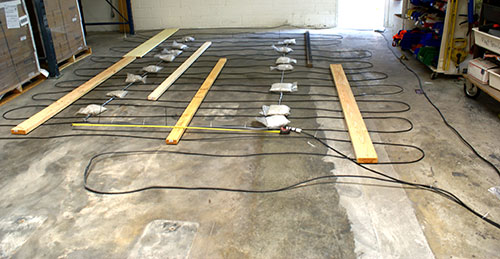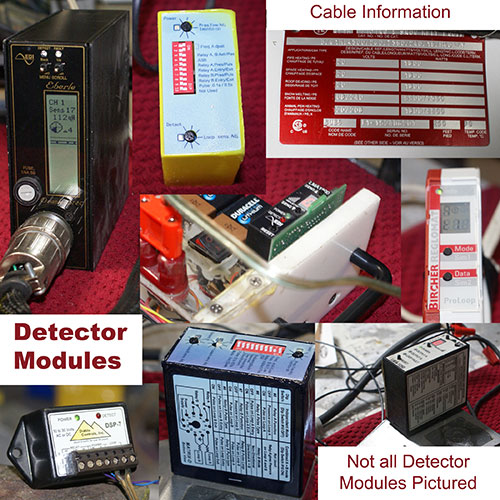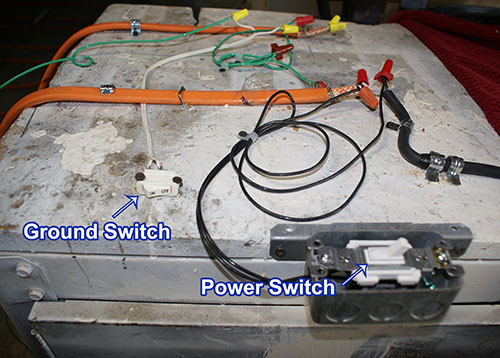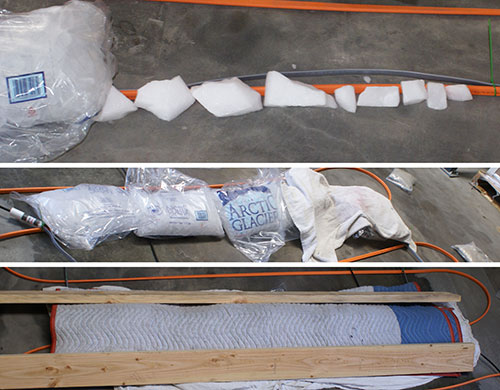Tests & Results
Loops and Snow-Melt Systems
Purpose:
Observe and record the affect snow melt systems have on inductive loop performance.
Hypothesis:
When the loop is connected to a fully featured access control/gate detector module there will be no visible/recordable effect when the snow melt systems are cycled on and off.
Materials:
- 1 – RL 18-40 (3×6 (18ft) loop with a 40ft lead-in)
- 1 – RL 36-40 (6×12 (36ft) loop with a 40ft lead-in)
- 220 Volt Snow Melt System #1: PENTAIR Pyrotenax MI Heating Cable System
- 220 Volt Snow Melt System #2: PENTAIR Raychem ElectroMelt System (self-regulating heating cables)
- EDI LMA 1250
- EDI LMA 1800
- EDI Oracle S1EC (Traffic Detector Module)
- Diablo DSP-7
- Reno A&E B-3
- BEA Matrix 2S-110
- BEA Matrix 2-3-12-24
- ProLoop 2
- Ground Wire with switch that could either ground the snow melt system, or leave it ungrounded.
- Zip Ties and Sand bags to hold the loops and snow melt cords in place.
- Small metal plate for testing loop & detector function
Procedure:
We laid out the snow melt systems on the concrete floor of our warehouse following the snow melt system installation instructions.
Once the snow melt systems were in place we cable tied the direct burial loops to the snow melt systems. The direct burial loops were placed directly over the snow melt system and the short legs of each loop were cable tied directly to the snow melt cable to maximize exposure and the potential for interference to occur. (This is not how loops should be installed with snow melt systems in real world applications).
The Detectors were arranged on a work bench, and the loops were connected to each detector module individually as the testing took place. The detectors were set to their maximum sensitivity level.
Test Procedure:
1. The loops and detectors were tested with the small metal plate before running the snow melt tests to ensure the loops and detectors were functioning properly.
2. The snow melt systems were cycled on and off to see if the initial surge would cause any interference (false detections) with the loop detector.
3. If no interference occurred then the snow melt system was left on and the small metal plate was used to see if the loops and detectors were able to function normally.
We repeated these tests with the snowmelt systems grounded and ungrounded. Both of these systems MUST be grounded to comply with NEC/CEC. Always follow the snow melt system installation instructions.
Results:

Snow Melt System # 1: PENTAIR Pyrotenax MI Heating Cable System
Notes: For our first test we used the EDI Oracle traffic detector module, these detectors have 20 levels of sensitivity, and 8 frequency settings. They also provide more feedback than access control (gate) detector modules.
| EDI Oracle S1EC | ||||
| Sensitivity Level | Frequency Setting: | False Detection: | Interference: | Notes: |
| 1 (lowest) | 8 | NO | NO | No recordable interference. |
| 5 | 8 | NO | NO | No recordable interference. |
| 10 | 8 | NO | NO | No recordable interference. |
| 20 (Highest) | 8 | YES | YES | Cycling Detection 5-8Δ Range |
| 20 (Highest) | 1 | YES | YES | Detection Only when cutting power to snow melt system |
| 18 | 1 | NO | NO | No recordable interference. |
| 18 | 8 | NO | YES | Can observe slight fluctuations in graph on detector module, but no detections. |
| 19 | 1 | NO | YES | Lower Frequency Setting = less false detections and interference |
| 19 | 8 | YES | YES | Cycling Detection 1-2 Δ Range |
Our first test was very insightful; we did see false detections and interference on the highest 2 sensitivity settings (19 + 20). The frequency setting drastically lowered the strength of the interference from the snow melt system. Sensitivity settings 18 and below had no interference or false detections. Grounding the snow melt system did not impact the results of the testing; however, to comply with building codes the snow melting systems must be grounded and installed per manufacture instructions.
Next we tested the gate access control detector modules:

| EDI LMA 1250 | ||||
| Sensitivity Level | Frequency Setting: | False Detection: | Interference: | Notes: |
| 9 (Highest) | HIGH | NO | NO | No recordable interference. |
| 9 (Highest) | LOW | NO | NO | No recordable interference. |
| EDI LMA 1800 | ||||
| Sensitivity Level | Frequency Setting: | False Detection: | Interference: | Notes: |
| 9 (Highest) | HIGH | NO | NO | No recordable interference. |
| 9 (Highest) | LOW | NO | NO | No recordable interference. |
| Reno A&E B3 | ||||
| Sensitivity Level | Frequency Setting: | False Detection: | Interference: | Notes: |
| 8 (Highest) | HIGH | NO | NO | No recordable interference. |
| 8 (Highest) | LOW | NO | NO | No recordable interference. |
| Diablo DSP 7 | ||||
| Sensitivity Level | Frequency Setting: | False Detection: | Interference: | Notes: |
| N/A | N/A | NO | NO | No recordable interference. |
| N/A | N/A | NO | NO | No recordable interference. |
| BEA Matrix 2S-12-24 | ||||
| Sensitivity Level | Frequency Setting: | False Detection: | Interference: | Notes: |
| 7 | HIGH | YES | YES | |
| 7 | LOW | YES | YES | |
| 5 | HIGH | NO | NO | No recordable interference. |
| 5 | LOW | NO | NO | No recordable interference. |
| BEA Matrix 2S-110 | ||||
| Sensitivity Level | Frequency Setting: | False Detection: | Interference: | Notes: |
| 1 | HIGH | NO | NO | No recordable interference. |
| 2 | HIGH | NO | NO | No recordable interference. |
| 3 | HIGH | NO | NO | No recordable interference. |
| 4 | HIGH | YES | YES | Any setting over sensitivity of “3” results in false detections and interference. |
| ProLoop2 | ||||
| Sensitivity Level | Frequency Setting: | False Detection: | Interference: | Notes: |
| 9 (Highest) | 4 | NO | NO | No recordable interference. |
| 9 (Highest) | 1 | NO | NO | No recordable interference. |
Snow Melt System #2: PENTAIR Raychem ElectroMelt System

This snow melt system uses self regulating cables. Again, we begin our tests with the Oracle traffic detetor module.
| EDI Oracle S1EC | ||||
| Sensitivity Level | Frequency Setting: | False Detection: | Interference: | Notes: |
| 20 (Highest) | 1 | NO | NO | No recordable interference. |
| 20 (Highest) | 8 | NO | NO | No recordable interference. |
| 19 | 1 | NO | NO | No recordable interference. |
| 19 | 8 | NO | NO | No recordable interference. |
We tested this snow melt system with the Oracle detector module multiple times, the results were
always the same: No recordable interference or false detections. Grounding the snow melt system
did not impact the results of the testing; however, to comply with building codes the snow melting systems must be grounded and installed per manufacture instructions.

Next we tested the access control (gate) detector modules:
| EDI LMA 1800 | ||||
| Sensitivity Level | Frequency Setting: | False Detection: | Interference: | Notes: |
| 9 (Highest) | HIGH | NO | NO | No recordable interference. |
| 9 (Highest) | LOW | NO | NO | No recordable interference. |
| EDI LMA 1250 | ||||
| Sensitivity Level | Frequency Setting: | False Detection: | Interference: | Notes: |
| 9 (Highest) | HIGH | NO | NO | No recordable interference. |
| 9 (Highest) | LOW | NO | NO | No recordable interference. |
| Diablo DSP 7 | ||||
| Sensitivity Level | Frequency Setting: | False Detection: | Interference: | Notes: |
| N/A | N/A | NO | NO | No recordable interference. |
| N/A | N/A | NO | NO | No recordable interference. |
| BEA Matrix 2S-110 | ||||
| Sensitivity Level | Frequency Setting: | False Detection: | Interference: | Notes: |
| 7 (Highest) | HIGH | NO | NO | No recordable interference. |
| 7 (Highest) | LOW | NO | NO | No recordable interference. |
| Reno A&E B3 | ||||
| Sensitivity Level | Frequency Setting: | False Detection: | Interference: | Notes: |
| 8 (Highest) | HIGH | NO | NO | No recordable interference. |
| 8 (Highest) | LOW | NO | NO | No recordable interference. |
| ProLoop2 | ||||
| Sensitivity Level | Frequency Setting: | False Detection: | Interference: | Notes: |
| 9 (Highest) | 4 | NO | NO | No recordable interference. |
| 9 (Highest) | 1 | NO | NO | No recordable interference. |
No false detections or interference occurred on any of the access control detector modules that
were tested.
All results were nearly identical for both loop sizes (18ft perimeter loop vs. 36ft perimeter loop).
After the initial test we took dry ice and bags of ice and placed them along the leg of the 6×12’
loop and the snow melt cable that it was cable tied to. We covered this area in ice and then
insulated it with moving blankets and planks of wood to help prevent the cold from escaping.
This snowmelt system is designed in a way where it will increase heat in colder areas (self regulating cables). We ran the tests again using the traffic detector module to see if a cold spot would cause interference with the loop.

| EDI Oracle S1EC | ||||
| Sensitivity Level | Frequency Setting: | False Detection: | Interference: | Notes: |
| 20 (Highest) | 1 | NO | NO | No recordable interference. |
| 20 (Highest) | 8 | NO | NO | No recordable interference. |
| 19 | 1 | NO | NO | No recordable interference. |
| 19 | 8 | NO | NO | No recordable interference. |
There was no interference, even with the cold spot.
Conclusion:
Loops can be installed over snow melt systems. Most loops installed with snow melt systems are unlikely to experience false detections or interference. Larger loops slightly are more prone to interference than small loops, but with most loop detectors this isn’t an issue at all.
Grounding the snow melt system did not impact the results of the testing; however, to comply with building codes the snow melting systems must be grounded and installed per manufacturer instructions.
That being said, detector choice is very important when installing loops with snow melt cables. As you can see in the results there were quite a few detector modules that NEVER experienced false detections or interference with either snow melt system.
Another interesting finding was how different the results for the two snow melt systems were. The first snow melt system caused false detections on 3 of the detector modules that were tested. The false detections did mostly occur when the detectors were set to high sensitivity settings and the false detections and inference
noticeably improved when the detectors were set to low frequency settings. In real world applications detector modules are very rarely set to their highest sensitivity settings.
Electric snow melt systems typically are run on a 220-230/60Hz volt system. In other tests we have run on inductive loops and power lines we found that 60Hzs systems do not affect vehicle detectors because most detectors run at a frequency of 50kHz to 120kHz which is far outside the rage of harmonic distortion. To learn more about how power lines affect inductive loops click here.
What this means, BD Loops Comments:
This was a very insightful test, what has surprised us most about the results was how differently the two snow melt systems affected the loops.
Conducting this test has convinced us of 3 things:
1. BD Loops preformed loops are the best loops to install with a snow melt system. Here is why:
a. Snow melt systems must be installed close to the surface to work properly, this means you need to use a loop that can be tied directly to the snow melt system, because standing the loop off from the snowmelt system will put you right at or above the surface.
b. Our preformed loops have an outer jacket and are more rugged than loops wrapped by hand. This is important because the snow melt cables will get hotter in any area where the loop comes into contact with it. In the case of the first snow melt system we tested, it can become so hot that the outer jacket/coating of the snowmelt system can melt.
c. Our preformed loops are thin, which means very little of the loop wire will be in direct contact with the snow melt system. This will help prevent the snow melt cable from being damaged.
2. If you are installing loops in an application that will have a snow melt system then the snow melt system used in test #2 the ElectroMelt self-regulating heating cable is the best choice.
a. In our testing this snow melt system did not cause any interfere with any of the detector modules that were tested.
3. Picking the proper detector module for the system is very important. Especially if you have no say in what type of snow melt system will be installed.
a. In our testing there were quite a few detector modules that performed very well, and did not experience interference or false detections on either snow melt system. These detectors will give you the best chances
of success in your snow melt application.
We are so glad we were finally able to run this test, we often receive questions about loops and snow melt systems and we finally have solid recommendations that we can give to installers.
Thank you to Pentair for supplying us with the snow melt systems to run these tests, and answering our questions about the systems.
The snow melt system that did not cause any interference or false detections with the loop detectors is the: PENTAIR Raychem ElectroMelt System (self-regulating heating cables)
If you have any questions about this test, please do not hesitate to contact us.
BD Loops
The Loop Experts!
BD Loops was founded in 2001. Their preformed loops and accessories are designed with the installer in mind. BD Loops offers a complete loop system solution including preformed direct burial loops, preformed saw-cut loops, loop sealant, blades, testing devices, and installation tools. BD Loops has a reputation for reliability and ease of installation. They pride themselves on the quality of their products and their commitment to providing excellent customer service and support. BD Loops preformed loops are made in the USA at their facility in Placentia, CA.

